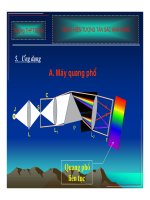bài giảng vật lý bằng tiếng anh thermodynamics
Bạn đang xem bản rút gọn của tài liệu. Xem và tải ngay bản đầy đủ của tài liệu tại đây (474.03 KB, 41 trang )
Thermodynamics
Temperature, Heat, Work
Heat Engines
Introduction
In mechanics we deal with quantities such
as mass, position, velocity, acceleration,
energy, momentum, etc.
Question: What happens to the energy of
a ball when we drop it on the floor?
Answer: It goes into heat energy.
Question: What is heat energy?
The answer is a bit longer.
In Thermodynamics we deal with
quantities which describe our system,
usually (but not always) a gas.
Volume, Temperature, Pressure, Heat
Energy, Work.
We all know about Volume.
Pressure:
Force
Pressure =
Area
Demonstrations: Balloons, Bed of Nails, Magdeburg hemispheres.
Example
120 lb woman putting all her weight on
2in2 of heals.
Pressure = 120 lb/2in2 = 60 lb/in2.
Is that a lot?
Comparison: 1 atm = 14.7 lb/in2. Thus of
heals is approximately 4 atm.
This is the pressure you would feel at a
depth of approximately 133 ft of water.
Temperature and Heat
Everyone has a qualitative understanding
of temperature, but it is not very exact.
Question: Why can you put your hand in a
400° F oven and not get instantly burned,
but if you touch the metal rack, you do?
Answer: Even though the air and the rack
are at the same temperature, they have
very different energy contents.
Construction of a Temperature Scale
Choose fixed point temperatures that are easy to
reconstruct in any lab, e.g. freezing point of
water, boiling point of water, or anything else
you can think of.
Fahrenheit: Original idea:
0°F
Freezing point of Salt/ice
100°FBody Temperature
Using this ice melts at 32°F and water boils at
212°F (Not overly convenient) Note: 180°F
between boiling an freezing.
Celsius (Centigrade) Scale:
0°C
Ice Melts
100°C
Water Boils
Note a change of 1°C = a change of 1.8°F.
Conversion between Fahrenheit
and Celsius
If we know Celsius and want Fahrenheit
9
F = C + 32
5
If we know Fahrenheit and want Celsius
5
C = ( F − 32)
9
Absolute or Kelvin Scale
The lowest possible temperature on the
Celsius Scale is -273°C.
The Kelvin Scale just takes this value and
calls it 0K, or absolute zero.
Note: the “size” of 1K is the same as 1°C.
To convert from C to K just add 273.
K=C+273
When do you use which scale.
Never use Fahrenheit, except for the
weather.
You can always use Kelvin and you must
use Kelvin when doing absolute
temperature measurements.
You can use either Kelvin or Celsius when
measuring differences in temperature.
Heat
Heat is the random
motion of the particles
in the gas, i.e. a
“degraded” from of
kinetic energy.
Nice web simulation
gas simulation
The higher the temperature, the faster the
particles (atoms/molecules) are moving,
i.e. more Kinetic Energy.
We will take heat to mean the thermal
energy in a body OR the thermal energy
transferred into/out of a body
Specific Heat
Observational Fact: It is easy to change the temperature
of some things (e.g. air) and hard to change the
temperature of others (e.g. water)
The amount of heat (Q) added into a body of mass m to
change its temperature an amount ∆T is given by
Q=m C ∆T
C is called the specific heat and depends on the
material and the units used.
Note: since we are looking at changes in
temperature, either Kelvin or Celsius will do.
Units of Heat
Heat is a form of energy so we can always
use Joules.
More common in thermodynamics is the
calorie: By definition 1 calorie is the
amount of heat required to change the
temperature of 1 gram of water 1°C.
1 Cal = 1 food calorie = 1000 cal.
The English unit of heat is the Btu (British
Thermal Unit.) It is the amount of heat
required to change the temperature of 1
lb of water 1°F.
Conversions:
1 cal =4.186 J
1Btu = 252 cal
Units of Specific Heat
cal J
Q
C=
= o = o
m∆T g C kg C
Note that by definition, the specific
heat of water is 1 cal/g°C.
Material
J/kg°C
cal/g°C
Water
4186
1
Ice
2090
0.50
Steam
2010
0.48
Silver
234
0.056
Aluminum
900
0.215
Copper
387
0.0924
Gold
129
0.0308
Iron
448
0.107
Lead
128
0.0305
Brass
380
0.092
Glass
837
0.200
Wood
1700
0.41
Ethyl Alcohol
2400
0.58
Beryllium
1830
0.436
Water has a specific heat of 1 cal/gmK and iron has
a specific heat of 0.107 cal/gmK. If we add the
same amount of heat to equal masses of iron and
water, which will have the larger change in
temperature?
1.
2.
3.
4.
The iron.
They will have equal
changes since the same
amount of heat is added
to each.
The Water.
None of the above.
Example Calculation
Compare the amount of heat energy required to
raise the temperature of 1 kg of water and 1 kg
of iron 20 °C?
Q = mC∆T
For Water
Q = ( 1000 g)(1cal / g C )(20 C ) = 20,000cal
o
o
For Iron
Q = ( 1000 g)(0.107cal / g oC )(20o C ) = 2140cal
Heat Transfer Mechanisms
1.
2.
3.
Conduction: (solids--mostly) Heat
transfer without mass transfer.
Convection: (liquids/gas) Heat transfer
with mass transfer.
Radiation: Takes place even in a
vacuum.
Conduction
Thermal
Contact Temperature
Conductivity Area Difference
Rate of =
Heat Flow
( Thickness )
Q κA
=
∆T
t
d
Example
Convection
Typically very
complicated.
Very efficient way to
transfer energy.
Vortex formation is
very common feature.
liquid convection
vortex formation
Sunspot
solar simulation









